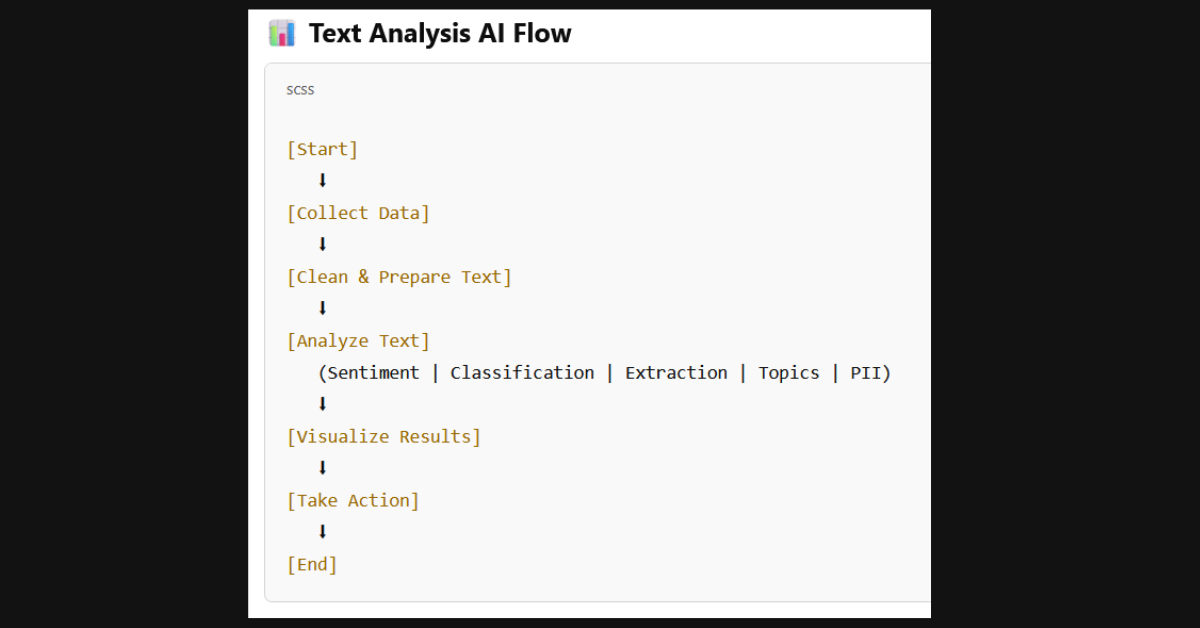Analyzing and Reading Texts AI: Using Automated Text Understanding to Unlock Business Insights
Businesses deal with an excessive amount of unstructured text from emails, social media, reviews, and other sources in today’s data-driven environment. It is not feasible to process this data by hand. Now let’s talk about text analysis. Reading and Text Analysis AI-AI is a revolutionary technology that can read, comprehend, and derive useful information from text. Let’s examine how it functions, why it’s important, and how it turns unstructured data into valuable strategic information.
Text Analysis: What Is It?
Text analysis is the process of reading human-written text and extracting business insights using computer technologies. To find trends, connections, and emotions, sophisticated software categorizes, sorts, and extracts data. For instance, it may examine social media postings to determine how people perceive a business or search through hundreds of product reviews to identify frequent concerns. Text analysis automates these processes quickly, accurately, and consistently in contrast to manual procedures.
Companies use this technology to handle unstructured data from surveys, papers, emails, and other sources. Imagine classifying customer service issues or quickly identifying unfavorable comments on Twitter without the need for human assistance. Text analysis makes this possible.

The Significance of Text Analysis in Contemporary Enterprises-Reading and Text Analysis AI
Businesses use internal communications, social media activity, and consumer feedback to inform their choices. But manually sifting through countless text sources takes a lot of time and is prone to mistakes. This issue is resolved using text analysis, which automates data processing.
Speed: Spend minutes analyzing large datasets.
Accuracy: Get rid of inconsistent and biased human behavior.
Actionable Insights: Create reports, graphs, and charts from raw text.
Scalability: Easily manage increasing data quantities.
For example, a sharp increase in unfavorable evaluations might notify teams of product defects before they become more serious. Likewise, real-time brand mention tracking enables marketers to react quickly to trends.
Fundamental Methods Underpinning Text Analysis-Reading and Text Analysis AI
Text analysis uses several sophisticated techniques to decipher text. Here are the main methods:
1. Analysis of Sentiment
Sentiment analysis identifies textual emotions like neutrality, negativity, and positivity. To gauge client happiness, it looks at forums, social media posts, and reviews. Statements like “love this product” or “terrible service” trigger sentiment tags. Businesses utilize this to monitor the health of their brands, manage public relations crises, and identify emerging trends.
2. Classification of Texts
This method categorizes text into predetermined groupings. Whereas machine learning models learn from examples, rule-based systems utilize keywords (for example, “slow” for negative feedback). To prioritize answers, retailers may categorize emails as “complaints,” “inquiries,” or “feedback.”

3. Extracting texts
Text extraction extracts certain information from unstructured text, such as names, dates, or keywords. Insurance companies use it to identify fraud by indicating contradictory claims. Common extraction tools include conditional random fields (CRFs) and regular expressions (REGEX).
4. Modeling of Topics
Topic modeling organizes related terms into topics. Articles regarding “AI advancements” or “climate change” may be automatically grouped by a news aggregator. This technique facilitates the analysis of topics in consumer feedback or the organization of big document collections.
5. Redaction of PII
Redaction of Personally Identifiable Information (PII) automatically conceals sensitive information, such as credit card numbers or addresses. This procedure helps healthcare providers adhere to privacy rules by anonymizing patient records.
How Text Analysis Operates: A Comprehensive Overview-Reading and Text Analysis AI
Text analysis uses natural language processing (NLP) and deep learning to simulate human comprehension. This is how it goes:
Phase 1: Information Collection
First, gather text from external platforms (forums, social media) and internal sources (emails, chats). Web scraping and third-party integrations are frequently needed for external data.
Phase 2: Preparing the Data
NLP techniques are used to clean and organize raw text.
Tokenization divides sentences into words or phrases.
Part-of-speech tagging assigns labels to words as nouns, verbs, etc.
Lemmatization is the process of reducing words to their root forms, such as “running” → “run.”
Elimination of Stop Words: Gets rid of words like “and” and “the.”
Phase 3: Text Evaluation
The program uses modeling, extraction, or classification methods. Through learning from fresh data, machine learning models gradually increase accuracy.
Phase 4: Visualization
We use dashboards, charts, or graphs to display the results. For instance, if a sentiment analysis report reveals a 30% rise in unfavorable reviews, quick action is necessary.

NLP and Deep Learning: The intelligence Behind Text Analysis
Deep Learning
Deep learning uses neural networks to process text in a manner similar to the human brain’s. Software may detect language, context, or irony thanks to these networks’ ability to spot patterns in data. For instance, they are able to differentiate between the positive statement, “This product is sick!” and the negative statement, “I feel sick.”
Processing Natural Language (NLP)
NLP connects computer comprehension with human language. Handwritten notes can be converted into digital text using methods like optical character recognition (OCR). Semantic analysis, meanwhile, interprets meaning; for example, it distinguishes between “bat” (animal) and “bat” (sports equipment).
Comparing Text Mining, Text Analytics, and Text Analysis
Text analysis identifies themes, mood, or intent in specific texts.
Text analytics: Finds patterns in big datasets (e.g., “slow delivery is mentioned in 40% of reviews”).
Unstructured text can be mined for qualitative insights.
Although both phrases are interchangeable, text analytics stresses quantitative measurements, whereas text analysis/mining prioritizes qualitative comprehension.
Applications of Text Analysis in the Real World
Personalization of the Customer Experience
Hotels use customer reviews to customize their offerings. Management can give improvements priority if visitors complain about “slow Wi-Fi” yet often compliment “friendly staff.”
Fraud Detection To identify possible frauds, banks look for phrases like “urgent” or “unrecognized” in transaction descriptions.
Healthcare Efficiency By automating the sorting of patient records, hospitals make sure that clinicians have quick access to vital information.
Brand Observation
To quickly resolve quality concerns, a cosmetics firm monitors social media for discussions of “allergic reactions.”
Upcoming Developments in Text Analysis AI developments will soon make it possible for
Understanding cultural quirks and idioms is known as context-aware analysis.
Real-time translation is the ability to translate and analyze multilingual content instantly.
Detecting subtle emotions, such as enthusiasm or dissatisfaction, is known as emotion detection.
In conclusion:
To sum up, AI-powered reading and text analysis is revolutionizing how companies analyze and comprehend enormous volumes of unstructured data. Businesses may use it to swiftly, precisely, and effectively extract important information, which helps them cut down on mistakes, save time, and outperform rivals. AI’s contribution to improving data analysis and decision-making will only increase as it develops. Businesses must analyze their data sources and implement AI solutions that support their objectives if they want to properly utilize this technology. Making decisions based on data is essential to being competitive in the future.



